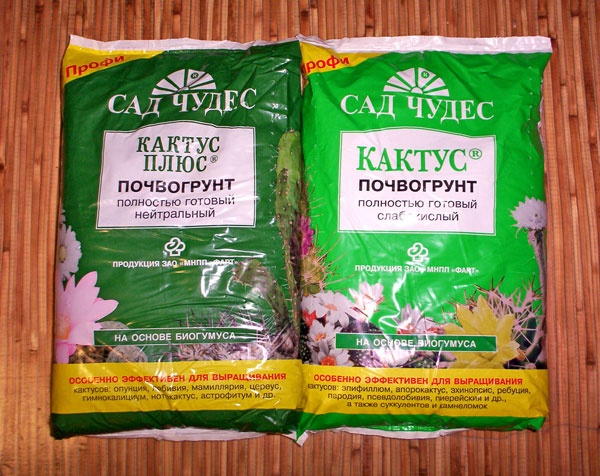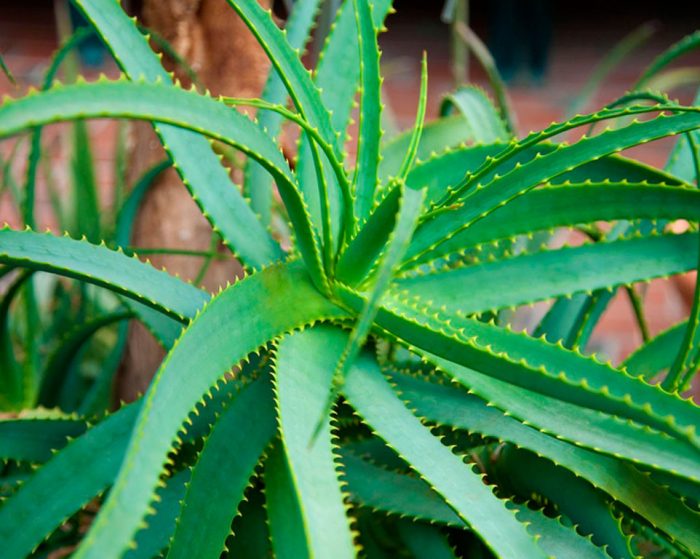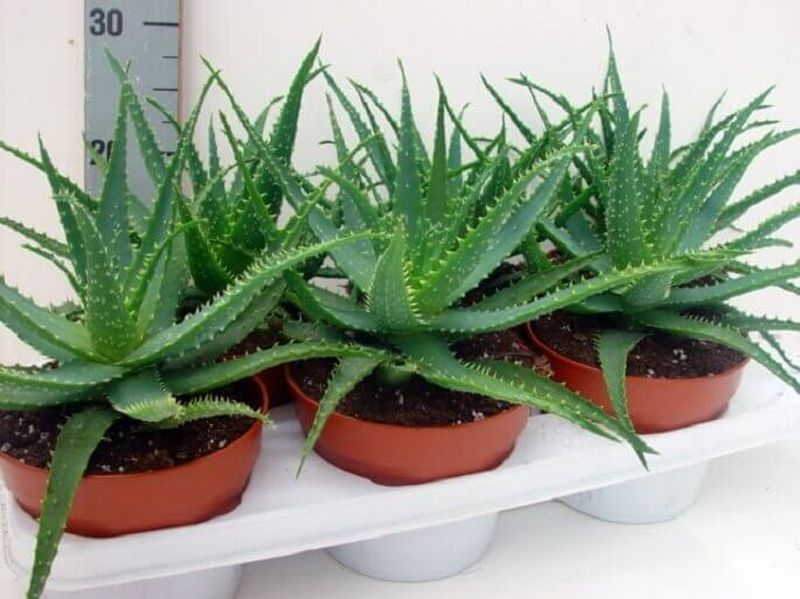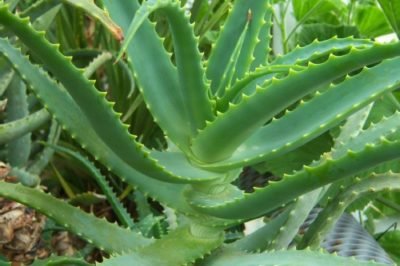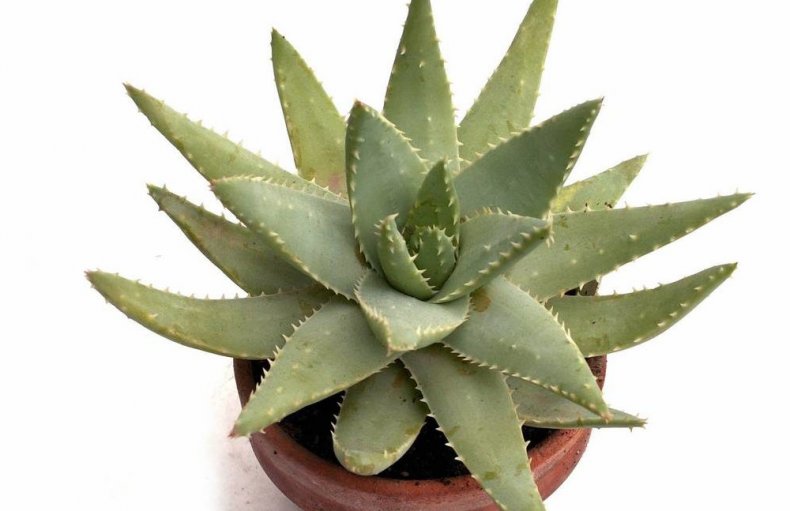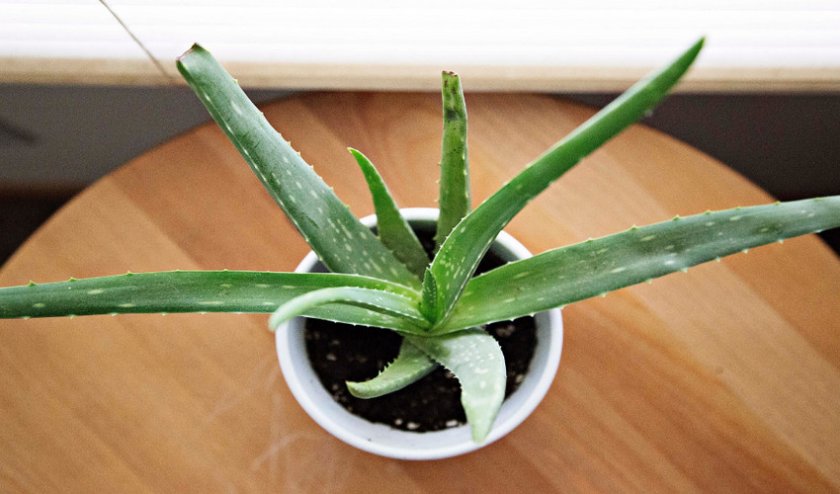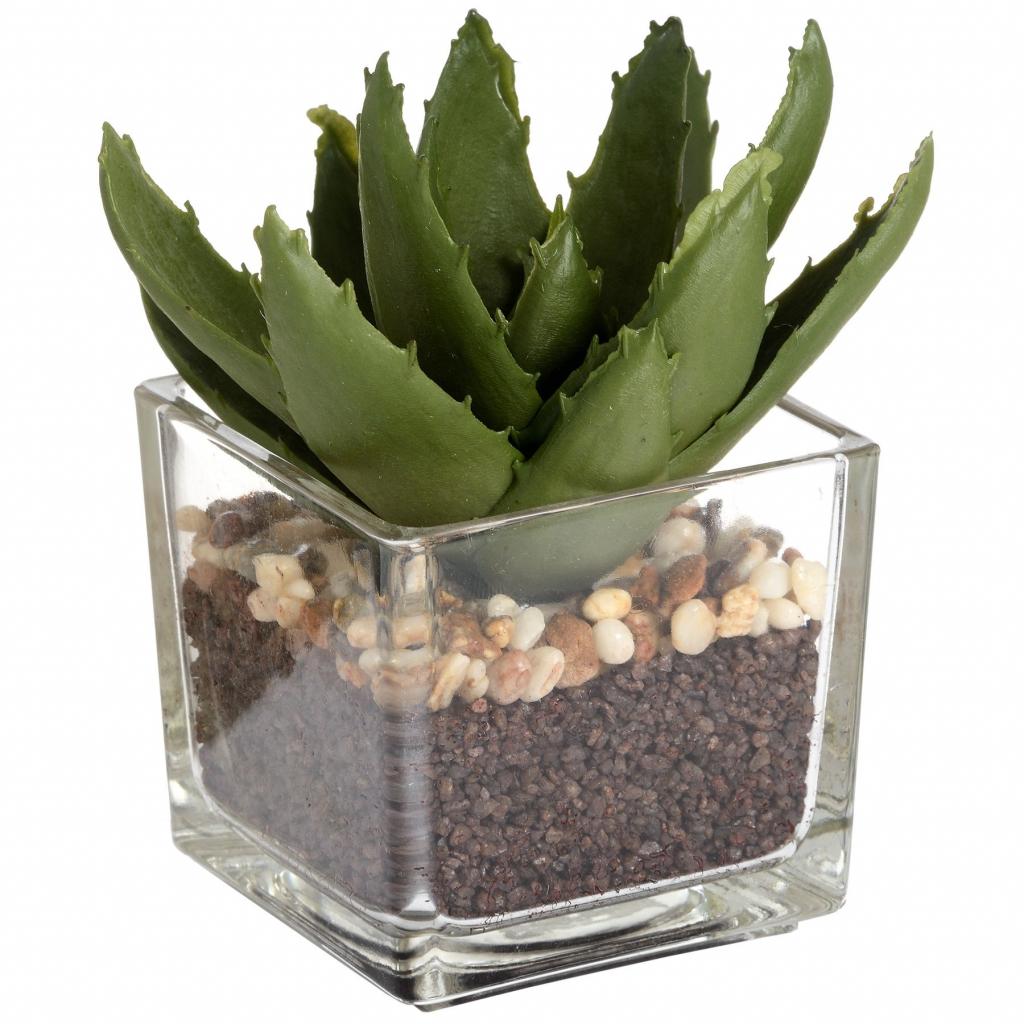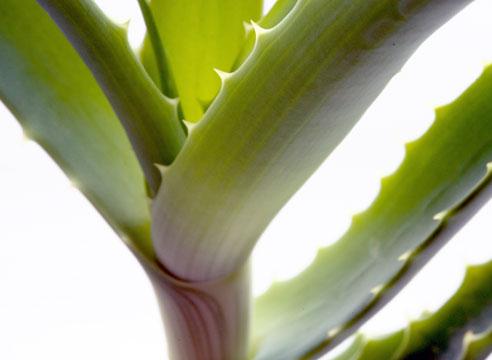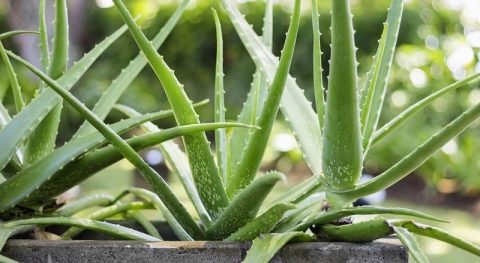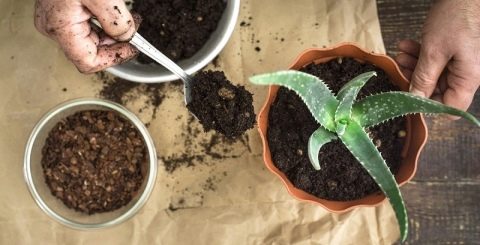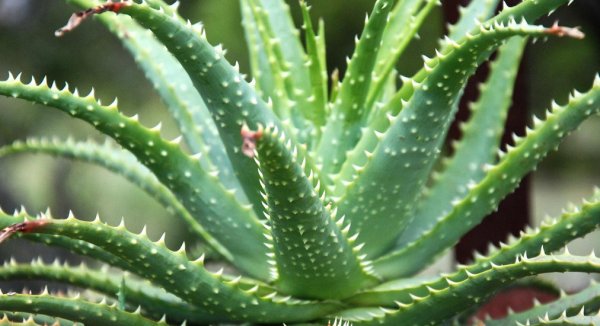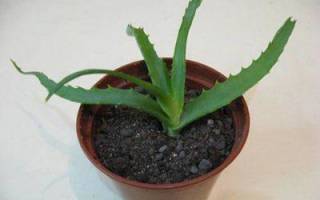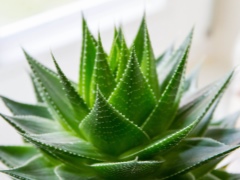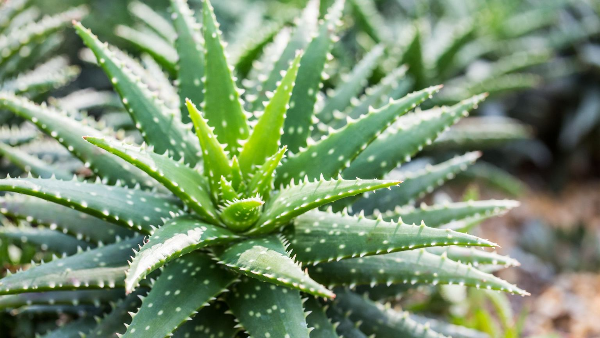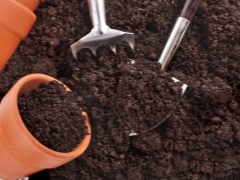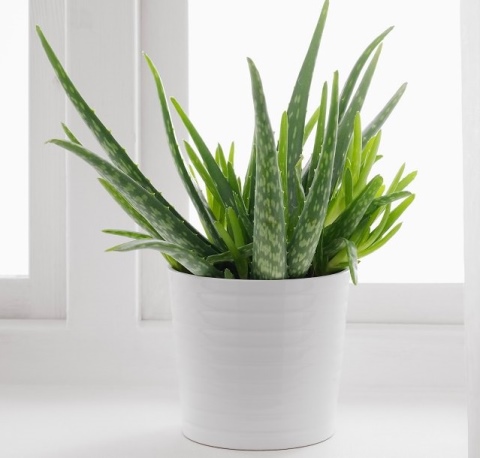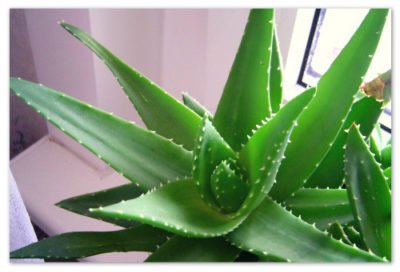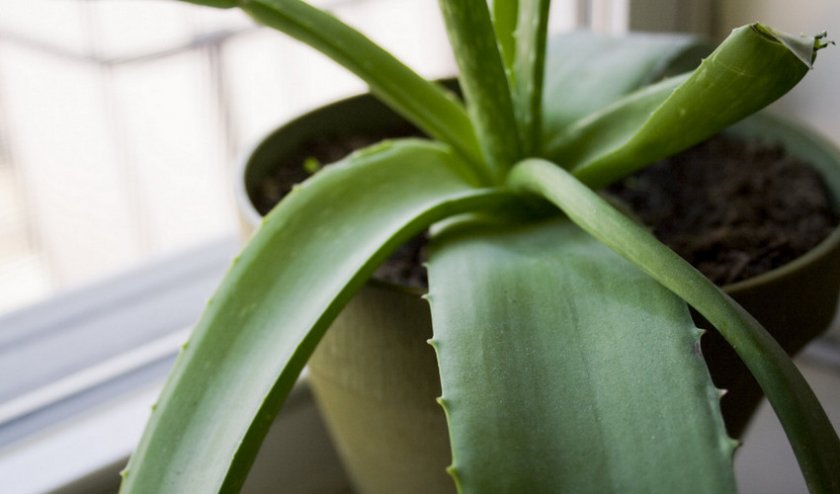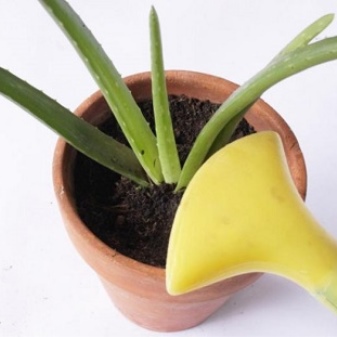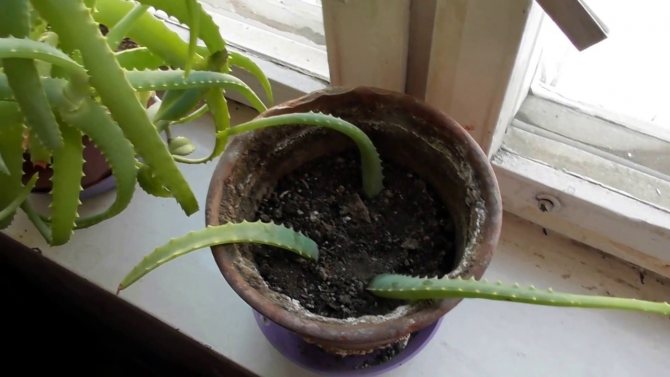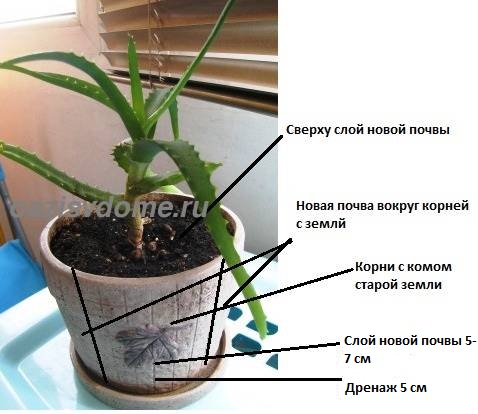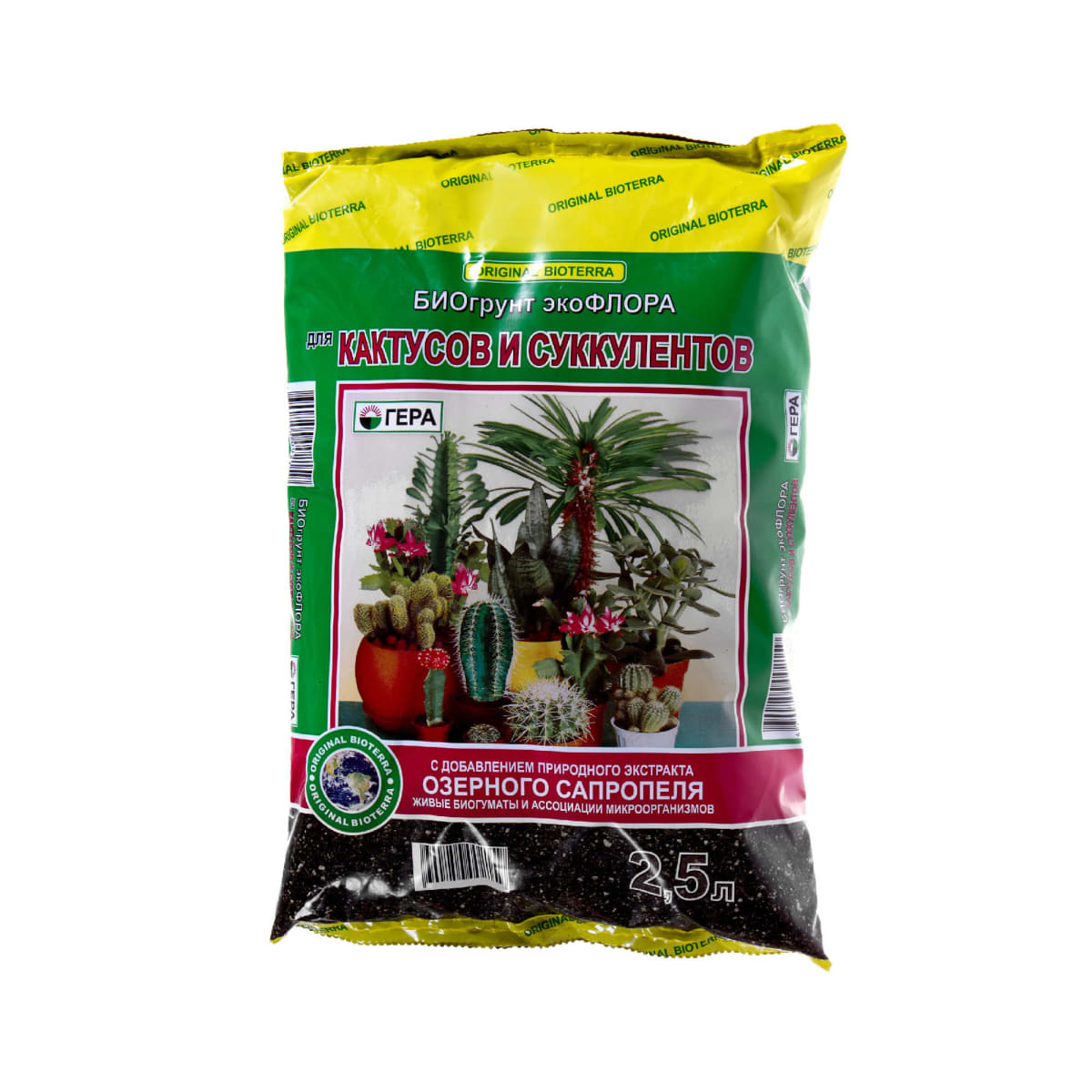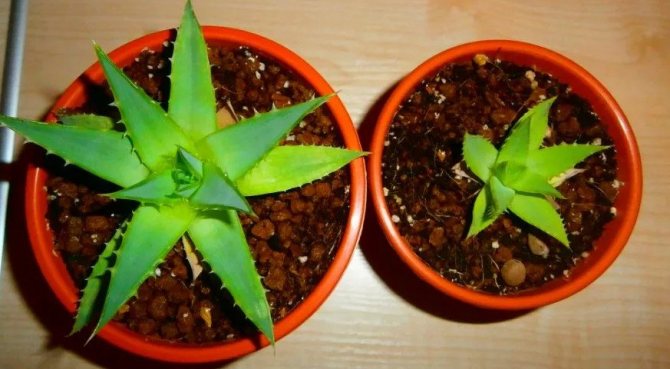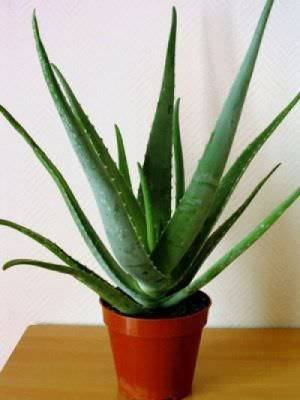What to do to make the aloe bloom?
Aloe bloom is a very rare event, because even in a greenhouse, this process occurs once every twenty years. And then, only special conditions are needed. And at home, the flowering of a plant is almost impossible to see.
During flowering, aloe grows from 30 to 80 cm peduncle, on which there are large inflorescences of tubular flowers. Different species have different flower colors.


If you are still determined to see aloe bloom at home, then you need to wait until the plant is 10 years old. Choose the winter period for preparation, because the plant needs a rest period before an important event.
- The temperature in which the aloe will be kept should be low (10-14 degrees). But additional lighting should be installed in the room in order to extend the daylight hours.
- Maintain dry indoor air to prevent root rot.
- For watering, use a pan with water, into which you will immerse the pot with the plant for 10 minutes.
Under such conditions, it is quite possible to see the flowering of the plant. The aloe flower has a very strong odor due to the large amount of nectar.
When the aloe blooms, the temperature can be raised by 10 degrees, but the light should be in the room with the flower as long as possible. If your aloe has been growing for more than 20 years, but does not bloom, then the conditions are not suitable for it. The plant can always be at rest, which is why it is called an agave.

In places of origin, aloe blooms 1-2 times a year. Most often, the plant blooms once a year for 6 months, with early spring to early autumn.
Features of caring for aloe at home
There are over 300 species of aloe, among which there are many medicinally valuable plants. In indoor floriculture, the following varieties are most popular: tree aloe, common aloe, tiger and many others.
The plant is native to hot Africa, so it grows well under continuous and bright light. The best place is the south-facing window sills. It does not need additional lighting in the autumn-winter period, it can withstand partial shade, which greatly facilitates the care of aloe.
Air temperature
The flower is undemanding to the temperature regime, but the optimal range in the summer is from +22 ° C to +26 ° C. In winter, a slight decrease is allowed, but not lower than +12 ° C.
Aloe will benefit from fresh air, so in summer, in good weather, it can be taken out on open terraces or balconies, however, in the midday sun it is better to hide the pot in the shade.
It is interesting! Aloe does not tolerate tobacco smoke, its leaves begin to gradually turn yellow and dry, the bush loses its former attractiveness.
Air humidity
This indicator does not really matter, aloe will feel quite comfortable when kept in rooms with dry air. But on especially hot summer days, you can sometimes pamper a flower with a cloud of the smallest refreshing drops from a spray bottle. There is no need to spray water directly onto the leaves, it is better to humidify only the air. The accumulation of water droplets in the rosette of leaves can lead to rotting or fungal diseases, especially if the air temperature in the room is below + 18–20 ° C.
Watering aloe
When caring for aloe at home, the florist should pay special attention to the watering procedure. The plant likes abundant watering with a little warm and soft water, in the summer months every 3-4 days. In winter, much less often, depending on the air temperature, but, as a rule, once every 2 weeks
The substrate should have time to dry between procedures. Considering that rotting of the leaf rosette is detrimental to aloe, many florists recommend using bottom watering, lowering the pot with the plant in water for 10 minutes
In winter, much less often, depending on the air temperature, but, as a rule, once every 2 weeks. The substrate should have time to dry between procedures. Considering that rotting of the leaf rosette is detrimental to aloe, many florists recommend using bottom watering, lowering the pot with the plant in water for 10 minutes.
The composition of the soil for growing aloe
To maintain a flower, a nutritious, but at the same time, loose substrate is required, which is well permeable to moisture and air. You can purchase a ready-made mixture for succulents or prepare it yourself:
- sod with the addition of clay - 2 parts,
- sheet land - 1 part,
- coarse sand - 1 part.
You can add a handful of charcoal to the prepared soil and prepare good drainage from expanded clay or broken brick.
Fertilization
In the phase of active growth, caring for aloe at home should include regular fertilizing with mineral-containing compounds, especially elements such as phosphorus and potassium are needed. You can purchase a universal complex designed specifically for succulent plants, it contains all the substances necessary for the growth and development of this type of plant. The frequency of top dressing is 1 or 2 times a month; in winter, you do not need to fertilize the flower.
Attention! Organic fertilizing is undesirable for aloe, this leads to excessive "swelling" of the leaves and affects the decorative effect of the plant
Planting and transplanting aloe
Aloe can grow and develop well throughout life, and some species can reach a height of more than a meter, so it is recommended to replant young specimens annually, and adults every 3 years. For transplanting, you need to purchase a new container, the volume of which is 20% more than the previous one. Drainage should be poured into the container, a little soil and the plant should be placed in the center, it should be planted at the same depth at which it was in the previous pot. Then, spread the rest of the mixture evenly around the bush. In the first days after planting, you need to moisten the soil very sparsely, then continue caring for the scarlet as usual. The most favorable time for a transplant: March-April.
What is aloe vera and agave, what is the difference between them, where is the birthplace of the plant?
Aloe is a great remedy that can help relieve pain and speed up the healing process of cuts, and heal chronic conditions. There are many varieties of this plant. But the most common in our region are:
- Aloe tree-like (also called "agave")
- Aloe vera
Aloe is a succulent plant that does not need abundant watering. In winter it needs to be watered not more often than once a month, in summer a little more often.
Medicinal properties of the plant:
- Relief of pain and faster healing of cuts
- Facilitates the course of broncho-pulmonary disease
- Reduces pain in stomach diseases
- Improves Eye Disease Situation
- Aloe is indispensable in cosmetology for skin and hair
- The plant has many useful components that strengthen the immune system.
In aloe, both pulp and juice are beneficial. The lower thick leaves are suitable for the pulp. When the tip of the leaf begins to dry out a little, it means that the plant has given up the maximum share of nutrients and the leaf is ready for use.
To use the pulp, you need to put the leaf in the refrigerator for several days and, after rinsing with boiled water, remove the skin. The pulp can now be used.
The centenary is most often used for external use, namely for:
- Healing wounds and eczema
- Soothing dermatitis
- Healing boils
- Acceleration of tissue regeneration in case of burns or frostbite
- Relief of the course of varicose veins
- Moisturizing the skin
- Reduce wrinkles
- Reducing itching from insect bites
- Strengthening hair, getting rid of dandruff
- Smoothing of postoperative scars
Aloe vera is used internally for:
- Strengthening immunity
- Stabilize blood sugar
- Preventing Digestive Disorders
- Strengthening the heart muscle
- Solutions for gum problems
- Reducing inflammation in arthritis
- Improving the functioning of the genitourinary system


But there are also contraindications for the use of both plants. So:
- Aloe vera should not be used by people with low blood sugar, as this plant can lower the value even more.
- People who have experienced vasospasm should also carefully approach the use of the plant. Since aloe leads to the fact that the vessels become even wider.
- It is also not advisable to use aloe for pregnant women. The risk of bleeding is not excluded.
- Aging is prohibited in oncology, as it promotes the growth of cells in the body and it is possible that cancer cells will multiply when using the plant.
- With purulent wounds, first you need to remove the pus, and then use the agave. Since the top of the skin will heal, and the pus inside will remain.
Caring for aloe at home after planting
After planting, the plant needs quality care. If important rules are not followed, aloe can die without reaching the required growth.
The basic rules are:
suitable lighting. The plant is very fond of bright light, so the brightest place is chosen for it.
It is important to install the container so that the sun's rays do not fall on the leaves, so as not to cause burns on them. In winter, artificial lighting may be required for aloe;
temperature
Aloe is a thermophilic plant. In the summer, the room temperature will be comfortable for him, it is allowed to take the pot out to fresh air. In winter, aloe begins a dormant period, a suitable temperature for it will be 14 ° C;
aloe transplant is carried out when the pot becomes small. A more spacious container is prepared for a new planting. Drainage is poured at the bottom, transplanted by the transshipment method together with a lump of earth.
A young plant must be handled carefully so as not to disrupt its growth and development.

Leaves in water to get roots
How to feed aloe
For fertilizing aloe, mineral preparations are suitable, which can be bought in specialized stores. The procedure is carried out from May to October every 3 weeks. In the winter period, feeding is not needed, because the culture begins a dormant period.
When carrying out the procedure, you need to pay attention to some features:
- in the first six months after planting, it is not recommended to feed aloe, because such a procedure is meaningless and unnecessary;
- if the aloe was planted in a special soil for succulents, then fertilization is not necessary for 8-9 months;
- all fertilizers are applied together with water for irrigation, they are not used on their own to avoid root burns;
- in the summer, twice a week, you can feed with a special fertilizer for cacti. This will stimulate the growth and development of culture;
- if the plant is sick, then it can be fed only if the cause of the disease has been established and a way to eliminate it has been selected.
Important! You can not use mineral dressings if you plan to use aloe for medical and cosmetic purposes

Planting leaves for rooting
How to water properly so as not to destroy a young plant
During the rooting of the flower, the moisture of the soil is monitored. After the culture is planted in a permanent place, it is worth carefully monitoring the condition of the soil in the pot.
For irrigation, do not use tap water immediately. It is required to leave the container under the lid for several days so that it settles.In winter, aloe should not be watered with cold water, the temperature should be 6-8 ° higher than room temperature.
Note! Watering a young aloe is carried out only under the roots; it is permissible to periodically pour water into the pan so that the roots are saturated with moisture. Spraying the flower is not really necessary
You cannot carry out a similar procedure if direct sunlight falls on the leaves. This can cause severe burns.
Spraying the flower is not particularly necessary. You cannot carry out a similar procedure if direct sunlight falls on the leaves. This can cause severe burns.
It is recommended to periodically wipe the leaves with a soft cloth from dust accumulation.

You can grow aloe from seeds
Role of soil
Succulent is able not only to decorate the interior, but also to help in the fight against runny nose, acne and skin aging. The rich vitamin and mineral composition of aloe allows you to use it for the preparation of masks, lotions and ointments. However, all these healing properties will only be effective with proper care and nutrition. If the plant develops safely and receives enough nutrients, it is able to evaporate phytoncides, disinfecting the air in the room and activating the protective functions of the human body. Caring for an indoor succulent is a simple matter, following simple rules you can get a strong and beautiful plant with a rich chemical composition.

Care after landing
Aloe is an unpretentious plant, it does not cause much trouble to flower growers. Loves bright, well-lit places. It is better to keep the container with the flower on the south side - the aloe is not afraid of direct sunlight. In extreme heat, it is better to move the succulent away from the window so that the fleshy foliage does not cook in the sun.
Active growing season begins with the arrival of spring, at this time, watering is increased, feeding begins. In summer, the flower is sprayed from a spray bottle to slightly moisten the leaves. With the onset of warmth, you can take the aloe container out to the balcony or garden, providing a comfortable place to stay in the sun, not during the hottest part of the day.
Dormant period
Vegetation ends in late autumn, aloe must be given time for winter rest. Watering is reduced (1 time in 15-25 days), the temperature must be lowered to 15-20 °. At this time, it is better to remove the flower from the windowsill, where it is heated by heating radiators. Aloe is not placed in dark places, the temperature below 10 ° is unacceptable for the plant.
Watering
With proper watering and hydration, aloe can grow quickly and look healthy. Recall that a succulent plant tolerates a lack of moisture more easily than an excess.
Above
Watering from above is undesirable for aloe. If you still have to water, the water is poured strictly at the root, without wetting the plant and preventing the appearance of puddles on the surface.
From below
The recommended method of irrigation is in a pallet. The settled water is poured for 20-30 minutes, after which the excess is drained from the pan. During this time, the earth will absorb the required amount of moisture.
Frequency
When choosing the frequency of watering, they are guided by the state of the flower, humidity and temperature in the room:
- the average rate in the summer, during the growth period - 1-2 times a week;
- when the growing season stops - once every 2-3 weeks.
If the ground is wet, watering is postponed, despite the coming date. It is especially dangerous to water too often in winter, when the air temperature is low and the water demand of the aloe is low.
Liquid top dressing
For aloe, liquid dressing is carried out according to the following rules:
- only healthy plants can be fertilized, feeding will only aggravate the disease;
- apply fertilizers in liquid form after watering;
- start feeding with the beginning of the period of intensive growth (March-November);
- the first feeding - 2-3 months after planting.
For fertilizing, fertilizers for succulents are used, folk remedies (onion husk solution, egg shells, sugar solution). The frequency of feeding is chosen based on the characteristics of the growing season - no more than 2 times a month, at least once every 2 months.
Possible problems
Aloe is not a sensitive or painful crop. Subject to the conditions of detention, the succulent is ill infrequently.
Rotten roots
With an excess of moisture, improper watering, the roots can rot. This happens more often during winter keeping with low temperatures. Decay can be detected by the increased mobility of the plant, a change in the type of leaves. Fungal diseases can kill aloe.
Recovery methods:
- watering normalization;
- transplant with the removal of decayed roots.
Mealybug egg-laying
Mealybugs and their clutches are removed by hand, the leaves are treated with an alcohol or garlic solution. If you cannot cope with folk remedies, use insecticides.
Among other pests of aloe, scale insects and spider mites are especially dangerous. Plants are examined regularly, damaged leaves are cut off. Treatments with chemical or folk drugs are repeated after 2 weeks, once is usually not enough.
Pruning
Cut off old and damaged leaves, which violate the decorative effect of the bush. For pruning, use a sharp knife or pruner (for large aloes). The instrument is preliminarily disinfected in a disinfectant.
Fundamental rules:
- The sheet is cut as close to the trunk as possible, trying to cut it straight, without burrs.
- For medicinal purposes, the leaves located at the base are cut (3-5 years old).
- Babies are removed from the pot so as not to weaken the mother plant.
Decorative pruning is done at the end of the dormant period.
How to choose the right soil?

Store substrates designed for succulents are perfect for transplanting. You can also use flower potting soil, diluted with sand at a ratio of four to one. Suitable proportions for soil are 4 parts peat, 2 parts turf and 1 part river sand.
The pot for the transplant is taken two centimeters wider than the previous one. Drainage is laid at ¼ of its height, then a layer of soil about 2-3 cm is poured and tamped. The flower is kept in the center and the remains of the earth are reported, two centimeters short of the edge. Finally, slightly moisten the soil.
A compulsory transplant is also required when buying a Kalanchoe. For sale, the flower is placed in a mixture of peat and coconut fiber, unsuitable for growing. If the plant does not bloom, then it can be transplanted immediately. In such cases, after the drainage layer, 2/3 of the volume of the pot is filled with soil, and after placing the flower, another 3 centimeters of earth is poured.
Transplanting the plant while it is in bloom is not recommended as it can be stressful and will require long-term care to recover. An exception is the transfer after purchase.
In this case, the flower is transferred carefully by the transshipment method. The transplanting procedure is almost the same, but after the drainage layer, you can pour a small amount of sand, and only then the soil
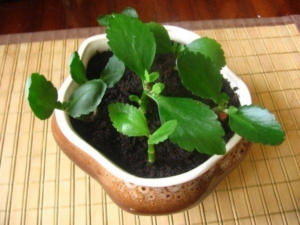
If you want to get an exotic Kalanchoe species that is rarely on sale, you can use seed propagation. For sowing them, it is necessary to make a sandy-peat soil. When planting, the seeds are slightly pressed into the ground and covered with glass or polyethylene, which are removed after germination.
What kind of soil is needed to plant aloe vera?
The natural habitat of the flower is considered to be countries with arid and hot climates. Because of this, aloe does not like too watery soil. The soil for it should not strongly retain moisture. Then the flower will feel comfortable.
When growing at home, the soil must meet the following criteria:
- good air flow;
- have a drainage layer;
- differ in sufficient looseness.
For aloe, sod or leafy soil is preferable. If the land does not suit him, it will immediately affect the appearance. The leaves will turn yellow first. And then the flower itself may die. It can only be saved by timely replanting.
What soil does he like: composition
Aloe loves soil with a neutral or slightly acidic reaction - with a pH in the range of 6.5-7.1. You can check the acidity level using a litmus test or a special device. The basic components of the potting mix include:
- humus;
- coarse sand;
- leafy land;
- sod land.
When preparing the soil substrate, a 2 cm thick drainage is first poured onto the bottom of the pot. The middle layer will consist of the soil mixture. And the upper layer should be made of coarse sand or gravel.
What land to plant on the street?
With the onset of spring, it is advisable to move the flowerpot outside or plant it in open ground. In the second case, it is necessary to carefully choose a place for the aloe. In this case, the following nuances are taken into account:
- There should be enough sun.
- In the lowland, the plant will feel bad due to stagnant moisture. It is better to place it on a dais.
- Sandy soil is preferable. In composition, it should be the same as for indoor plants.
It is recommended to transplant with an earthen clod directly from the pot. Before that, a layer of expanded clay is poured into the hole as drainage.
Purchased selection
The finished mixture contains all the nutrients in the right proportions. Purchased soil also has a normal acidity level. You can buy it at any flower shop.
When choosing a land for a plant, you should focus on the following features:
- the best option is a soil mixture for succulents;
- cactus soil is also suitable for growing aloe;
- in extreme cases, it is permissible to use a universal mixture and sand in a ratio of 4: 1.
What kind of feeding is suitable?
In the process of fertilizing, it is necessary to adhere to certain rules. Then it will benefit the plant. A flower just planted in the ground does not need to be fed. In the near future, he will have enough nutrients for full development.
Aloe will begin to need fertilizers after six months. Then feeding is carried out as follows:
- First, the soil is slightly moistened. Together with water, the roots will quickly absorb useful microelements.
- The solution should be low in concentration. It is better to pour it into the pallet. Leaves and stems can be burned if they come into contact with.
- Fertilizers are applied from May to September. The rest of the time, the flower is dormant. Then he does not need additional food.
- For active growth, it is enough to apply top dressing once every two weeks.
Correctly applied fertilizers strengthen the roots and improve metabolic processes. At the same time, the growth of the flower is stimulated and the resistance to the development of diseases increases.
Drainage
In the absence of free access to oxygen and increased density of the soil, the life span of the plant is reduced. Then its roots cannot breathe normally and fully absorb nutrients and moisture.
Therefore, when preparing the soil for aloe, it is imperative to take care of the drainage layer. It also maintains the optimum moisture level for the succulent. The drain is a layer of coarse material at the bottom of the planter. It performs the function of moisture outflow and ensures the air permeability of the soil.
The following are used as leavening agents:
- brick chips;
- gravel;
- perlite;
- expanded clay;
- charcoal.
These materials work well with any aloe substrate. But when choosing drainage, not only the materials themselves are important. The thickness of the interlayer also matters: it should be within 2-3 cm.
Transplant methods
Aloe multiplies easily:
- Transplant of a part of an adult color;
- Jigging the appendix;
- Parts of green leaves;
- Seeds.
Each method has some small tricks.
Transplanting an adult plant
You need to transplant the old aloe in the following cases: Buying a flower in a store. If the flower has "outgrown" the size of the pot. Diseases or pests have appeared in the ground. Stages of transplanting a whole plant:
- Watered for a day or two before transplanting.
- Free from the old container.The earth is shaken off slightly, old rotten roots are removed. If the transplant is caused by the presence of pests or diseases, the roots are washed from the ground completely.
- 2-3 cm of finished soil is poured onto the drainage layer.
- The plant is placed in the center of the pot. The roots should not be bent. The stem is placed 2-3 cm below the edge of the planting container.
- The roots are evenly covered with earth, lightly tamping.
- Watering is carried out strictly at the root. Moisture should not get on the rosettes of the leaves and cause rotting of the weak plant after transplanting.
- Protect from direct sunlight for 3-5 days.
Separation and deposition of the appendix
Shoots grown from the root are suitable for jigging. You can plant a baby aloe when a small plant has reached 5-10 cm in growth and has released 3-4 leaves. There are two ways to take a scion from an aloe:
The plant is removed from the pot, shaken off the ground. In this case, with a sharp knife, it is easy to separate all the processes along with the roots and an adult plant.
Small plants are transplanted into separate pots or into a "school" for growing
The shoots are carefully separated with a narrow spatula, trying not to damage the roots. An adult flower is not taken out, leaving it to grow in the same place
Without root
Aloe is successfully propagated by plant parts without roots:
- Cuttings;
- Leaves;
- The tops of lignified stems
Aloe cuttings are young shoots that have grown on the base, lateral stem or top of plants.
Cuttings or parts of leaves are cut with a sharp knife closer to the mother plant. After processing the cut site with activated carbon, the planting material is removed to a dark, cool place for wound healing. A leaf or stalk is planted in wet washed sand. In two weeks, the roots will appear.
After the plant has come to life, it has begun to grow, it is transplanted to a permanent place. A new plant is obtained by the “rootless” method from the tops of “wooden” stems. To do this, cut off the "crown" 2-3 cm below the leaves. The cut part is placed in a container with water. After the roots appear, the top is transplanted into a pot with earth.
Potential problems during and immediately after boarding
Often, planting and reproduction of aloe goes without any difficulties. But sometimes flower growers complain that this succulent does not take root. Therefore, you should find out why this is happening.
The most common cause of plant death is excessive soil moisture, which is associated with improper watering. To remedy the situation, it is necessary to remove the plant from the pot, clean the rotten areas and roots with a knife. After that, sprinkle fresh wounds with charcoal and dry for several days in a dark place.
Then plant in an equal proportion of sand and turf. Do not water the plant for the next 2 weeks. If during this time the decay process does not resume, then the soil in the pot can be slightly moistened. As soon as the plant fully grows stronger and grows, it must be transplanted into a full-fledged substrate.

Mealybug - a dangerous pest of succulents
Another reason that aloe does not take root may be a mealybug. This pest lays eggs in the roots of the plant. As a result, the larvae that appear feed on the sap of the plant, which prevents rooting. In this case, it is recommended to water the plant with a solution of the Aktara preparation (1.4 g per 6 L). After a week, spray the plant and soil in the pot with phytoverm.
Note! Treatments must be carried out until the pest is completely destroyed, alternating preparations
What to do if it does not take root
If, despite all the efforts spent, the aloe still cannot fully take root, you need to check if all the recommendations are followed. When planting and growing, everything matters, so even the smallest details should not be ignored.
Most often, the plant cannot fully take root, since the temperature regime is not observed during the rooting period. In this case, it is recommended to repeat the planting, while completely replacing the soil.You should also wash the pot well and scald it with boiling water.
Growing aloe, like other succulents, is not difficult, the main thing is to provide the plant with conditions that are as close as possible to its requirements. First of all, this concerns planting, since development in the future depends on it. Otherwise, even an inexperienced grower can cope with caring for aloe.
Consequences of liquid stagnation and poor ventilation in a flowerpot
As already mentioned, aloe does not tolerate stagnant liquid in a pot. If there is no drainage layer or it is of poor quality, then the water will linger for a long time. In this case, the root system will rot. For aloe, such a phenomenon is disastrous, since the flower grows in the wild in dry lands, even in deserts. It tolerates drought more easily than an excess of fluid.
An equally dangerous moment for aloe is poor ventilation in the flowerpot. When the air cannot penetrate into it unhindered. This is due to the lack of natural disintegrants in the composition of the soil. The consequences of compacted soil are yellowness and drying of the leaves.


